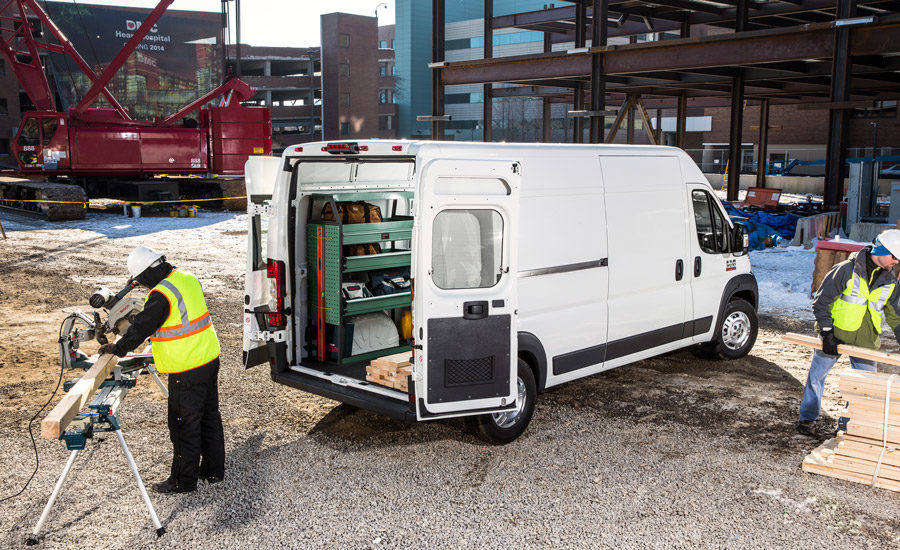ORLANDO, Fla. — While there were many eye-catching booths at the recent AHR Expo, those that showcased new work vehicles were perhaps some of the most popular among those in attendance. HVAC contractors descended upon the vehicles in swarms, opening and shutting doors and panels, kicking tires, and talking shop while exploring the many other new features these products have to offer. And, this year, manufacturers made sure attendees had plenty to look at.
THE RISE OF THE EUROPEAN VAN
Perhaps the biggest work-vehicle trend at this year’s Expo was the somewhat sudden and notable presence of European-style vans. More maneuverable and economical than previous van styles, these vehicles are built with tradesmen in mind.
David Elshoff, head of Ram brand communication, Ram Commercial, a brand of FCA USA LLC, said the company has aggressively promoted its ProMaster and ProMaster City van lines over the past year.
“A couple of years ago, we didn’t have commercial cargo vans in our lineup, but we were able to leverage our corporate partners at Fiat in Europe and put a lot of hard work into them to make them work in this country,” said Elshoff. “Along with that came the expertise that has grown up over time in Europe.”
Several public and private entities have already ordered a number of the RAM ProMaster vans, Elshoff added. “We have some large fleets that use our full-size ProMaster vans, like FedEx and UPS; we also received a very large bid from the USPS, which intends to purchase more than 9,000 of our full-size ProMaster vans. We’re growing every month.”
Ford Motor Co., which featured its full-size Transit van at the Expo, is also making a big splash into the Euro-style market in the U.S., though the company is no stranger to this vehicle category.
“We started building the Transit van in 1964 in Europe,” said Calvin Henderson, commercial business manager, Ford Commercial. “We’ve sold more than 7 million worldwide, and we just brought it to the U.S. last year. This van is replacing our Econoline van, which was the No. 1-selling full-size van for more than 34 years.”
BUILT FOR TRADESMEN
The newest generation of work vans is available in a variety of sizes and configurations and includes numerous features that benefit HVACR contractors and technicians.
“Ford offers a unibody construction,” Henderson said. “It has a stronger structure overall because strength may be added into the body when it’s designed, and that’s a plus when it comes to rollover and side-impact crash testing. It has a five-star crash test rating.”
The ProMaster van also features unibody construction. “This allows us to have a lower weight and higher payload, and that is a more efficient package,” Elshoff said, adding that the ProMaster City is rated at 21 mpg city and 29 mpg highway. It also features 131 cubic feet of cargo space.
To meet contractors’ demands, Ford offers three roof heights as well as back doors that open up to 270 degrees. “That’s a benefit for the HVAC techs, because if they have to put in a large unit, they don’t have to worry about height,” Henderson said. The Transit also offers dual sliding doors so the operator doesn’t have to walk around the van to get supplies and equipment.
On the ProMaster City, Ram made the rear doors a 60-40 split. “If you’re in an urban area, you can open the side you need and unload either your equipment or tools into the residence or business you’re going to, and it makes you more efficient curbside,” Elshoff said. Additionally, the ProMaster features FWD instead of RWD, reducing step-in height and making it easier to handle in slippery driving conditions.
The ProMaster and ProMaster City can also go longer between required maintenance, Elshoff added. For the gas engine, oil changes are only required once every 10,000 miles; for the diesel, it’s once every 18,500 miles.
“It’s higher-quality oil doesn’t breakdown as quickly, so they’re not spending money for all these extra oil changes,” he said. “They also run cleaner overall. We make sure we have a very efficient vehicle to operate.”
TRUCK CAPS
While many HVACR professionals are turning to vans to haul equipment and tools, others prefer truck caps, which fit on the beds of pickup trucks. Sean Brideau, key account manager at SpaceKap, a Canadian manufacturer of truck caps, said the product is popular because of its universal fit.
“The benefit of a unit like this one [at the AHR Expo], which is on an 8-foot, 2012 Ford F-150, is that I can take this on and put it on any truck, as long as it has an 8-foot bed.”
The truck caps are durable, and since they can be moved from vehicle to vehicle, they are not wasted if the vehicle breaks down. “People keep them as long as they can,” Brideau said. “I have people who have 23-year-old SpaceKaps on the road that have gone through seven different trucks.”
Like the ProMaster and Transit van series, SpaceKap has gone to one-piece construction for strength. “We laminate ribs into our system so we can attach all of our shelving and nothing gets bolted to the outside whatsoever,” Brideau said. “It has a patented tie-down system. We don’t modify the trucks in any way, so when this comes off, you have the exact same bed you had when you bought it. The tie-down system grips under the rail of the truck. The leasing companies really like it because they’re all about return on investment.”
The truck caps are also still somewhat novel, Brideau added, which can help draw attention to the company, especially if the topper is wrapped with a company logo.
“With the SpaceKap being a unique product in the market at this time, it’s quite an eye catcher,” he said. “So, from a marketing point of view, a lot of the guys we’re meeting now are saying, ‘Wow, it really caught my eye.’ The same thing is going to happen when you’re driving down the street in one.”
DESIGNING FOR USEFULNESS
Since the Transit and ProMaster Series of work vehicles are so new to the U.S. market, Ford and Ram engineers are making a point to listen to the end user to learn how they could improve their respective products.
“We conduct focus groups at trade shows,” Elshoff said. “And, often, the most important area is at a local level, where we have folks who work directly with dealers and make sales calls to individual contractors. There, we will look at their vehicles and see how they’re equipped and how they use them. We’re doing some research with the small vans right now, and we’ll send video-capable iPads out to a select group of contracting consumers and have them film aspects of their vans they do and don’t like, and they send that footage back to us.”
Elshoff and Henderson both said they anticipate sales of their work vehicles will only continue to increase in the next year as their Euro-style vans continue to gain popularity, at least in part due to the higher resale value of work vans compared to work trucks.
“The biggest investment was making sure the vans were durable in this country,” Elshoff said. “The driving cycles, temperatures, and use of salt are different here than in Europe.”
Henderson said Ford anticipates the Transit line will retain its value much like its predecessor, the Econoline.
“If I run a vehicle 100,000 miles and need to trade it to get rid of it, I’ll get a little more value for it,” he said. “With our Econoline vans, they hold their value, and it’s the same thing here — we feel it’ll be the same way with the Transit.”
Publication date: 2/22/2016
Want more HVAC industry news and information? Join The NEWS on Facebook, Twitter, and LinkedIn today!







